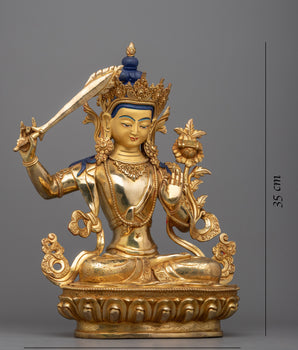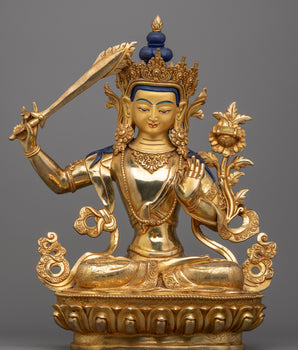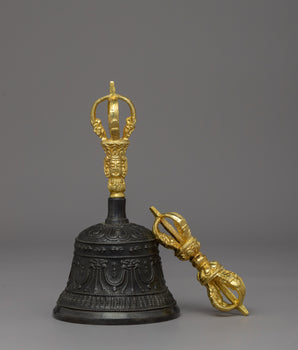A Practical Guide to Building Your Buddhist Shrine
A Buddhist shrine in your home is a respectful way to consider your spiritual progress. Besides its beauty, a shrine is a place devoted to religious worship, focus, and devotion. Evamratna means the particular way of putting together Buddhist altars, using important and symbolic items from Vajrayana and Tibetan Buddhism. The guide provides choices for every element and leads you in stages to design a strong and meaningful shrine with the Evamratna layout.
About Evamratna
Evamratna is a Nepali company that makes handmade Buddhist ritual objects and altar items. The collection includes various sacred objects inspired by traditional Tibetan and Himalayan art which are meant to support spiritual practice and make prayer rooms more peaceful. They produce various things, including thangka of gods, ritual tools, prayer wheels, mandalas and accessories for altars. The strong dedication to quality and truth, Evamratna is now trusted and appreciated by practitioners and collectors everywhere.
Buddhist Shrine: A Spiritual Space For Daily Life

In Buddhist thought, a shrine is where followers focus on praising the Buddha and helping their spiritual growth. It contains images of the Buddha’s features, says, and thoughts, helping to remember your devotion. Just as our inner mind expresses our views, a shrine expresses a person’s focus on and loyalty to Buddhist teachings. Each statue or painting in a shrine is there to encourage feelings of generosity, mindfulness, wisdom, and compassion. Over time, the shrine gives individuals comfort and allows them to concentrate, look at their goals, and complete their plans. Having a shrine is a daily reminder to be mindful. If organized sincerely, even a candle, a photo of Buddha, and a tidy space can have great meaning.
What Is The Purpose of a Home Shrine?

The establishment of a shrine in a sacred location that is both clean and tranquil is recommended. A serene, spotless area of the home, free from the bustle, is the optimal location for your shrine. It is generally considered uncouth to bring a mirror into one's chamber, particularly close to the area where one would place their feet or where they would be visible. This is an excellent idea if you have a tranquil corner in your living room or a serene meditation location in another room. Imagine creating an environment, you can unwind, disconnect from the daily grind, and reestablish a connection with your true self.
Creating a Buddhist Shrine, Step by Step
Constructing a shrine using the Evamratna method is intentional and connected to valuable customs. Each part of an asana has both a physical form and a thoughtful purpose. If you are just starting with spiritual practice or want to improve an existing one, this guide will help you establish a space that supports your spiritual journey.
Step 1: Choosing Your Sacred Space

Creating a Buddhist shrine starts from choosing a positive, clean, and isolated place away from daily activities. Try to situate the shrine somewhere quiet and away from anything noisy or crowded. The shrine is off the floor as a mark of respect for the items inside it. If your home is small, use mounted shelves or built-in niches. Arrange smaller things on a multi-level altar table.
You should place a meditation cushion, rug, or mat in front to encourage you to meditate, prostrate, or offer all your actions. A shrine should not be behind the toilet, beneath the stairs, or inside a bedroom, but kept in an elevated and completely enclosed place.
Step 2: Cleansing and Preparing the Space
Energetically and physically clean the site before placing any meaningful objects inside. Release staleness from a room by softly cleaning the surface and burning some frankincense, juniper, or sandalwood incense; purifying the space again by playing a bell or just sprinkling saffron water across it. The first intention is that this place will be filled with wisdom, compassion, and the power of awakening, as you build a shrine calmly. Even though the process seems very simple, it helps set the stage for all the activities that follow.
Step 3: Attending to the Three Jewels of the Body, Speech, and Mind

The Three Jewels are central to every Buddhist shrine and stand for the wisdom, kindness, and awareness of the Buddha’s body, speech, and mind. Placing these objects up front in a shrine since they hold the most importance. To honor the body, put a statue or thangka of the Buddha in an altar, such as Shakyamuni Buddha, Medicine Buddha, or Avalokiteshvara, depending on your path. Chanting from a text of the Dharma, such as the Heart Sutra, a collection of Dharma teachings, or even a scroll with mantras, is appropriate in Buddhist speech practice.
In Buddhist art, a small stupa, a mandala, or the sacred symbol (Om) is sometimes used to illustrate the awakened mind. The path and its goal are made clear through the three, reminding you of your purpose each time you stand at the altar.
Step 4: Collecting the Offerings for Fortunes
Eight offering bowls are placed in a line directly in front of the Three Jewels. Every bowl has a traditional item to encourage the person to increase in a valued trait, using a copper, brass, or glass bowl. Flowers can be delivered fresh, symbolizing purity, spiritual awakening, and enlightenment. The next is incense, symbolizing proper behavior and a clear mind. Light is the fifth aspect and is usually given by a butter lamp or candle. Offerings also include a small dish of rice, fruits, or sweets, meant to fill us and be generous. The last ritual includes music, which is shown with a little bell, cymbal, or conch shell, demonstrating the happiness and peace found in the Dharma. Perfume represents the purification of the space, mind, and could be shown as scented water or essential oils.
In Mahayana texts, using the fragrance as enlightened beings symbolizes their great spiritual strength, understanding, and compassion. Offerings can be set out or simply thought about with the same results.
Step 5: Bringing in Items for Sacred Practices

Adding personal objects and representations from your traditions is possible, in addition to the basic Three Jewels and Eight Offerings. Buddhists use a bell and a dorje (vajra) as symbols for the joining of wisdom and compassion. A mandala set is often part of the ceremony, to give all worldly beings to the enlightened ones. Prayer beads (mala) to recite mantras; set them aside on a shrine when not using them. Turning a prayer wheel to open the scrolls with mantras and spread the blessings. Putting a thangka or a religious painting above the shrine can bring good energy and benefit the whole home. They do more than just add beauty, and also help to change and shape a space.
Step 6: Engaging with Daily Practice and Offerings
When the shrine is ready, it becomes a real part of your spiritual life. Do your best to meditate at your altar every day, regardless of how long it lasts. Begin by lighting a candle or incense, making a bow, and changing the water daily in the bowls. For example, chanting “Om Mani Padme Hum” helps attract compassion, or standing in the spot and intoning “Om Ah Hum” can enrich the space and bless you. With continued practice of this ritual, spiritual life becomes more energetic, and mindfulness grows stronger. The most important thing is maintaining a bond and being committed, not how detailed or grand a shrine is.
"Om Mani Padme Hum"
“Om Ah Hum”
Step 7: Maintaining Your Shrine with Respect

Taking care of a shrine by cleaning and maintaining it is a way to practice your spiritual life. Deal with the shrine like it is setting up for the Buddha to be your guest: thoughtfully, with respect and affection. The strong intentions in a room shape the energy and offer assistance back to you.
Suggestions for Improving Your Buddhist Shrine
Setting up your basic shrine is a good start; adding something special and meaningful can help your practice become even more meaningful. Some meaningful ideas to encourage you:
|
Addition |
Purpose |
How It Helps |
|
Seasonal & Lunar Offerings: |
Offer items during the seasons, during eclipses, or on special Buddhist holiday periods. |
Helps practice at spiritual turning points and connect more deeply with the spiritual world. |
|
Inspirational Quotes or Mantras: |
Mount a poem, quote, or saying on the wall next to your shrine. |
Inspires your mind and keeps it attentive to spiritual teachings. |
|
Reflection Journal: |
Always have a little notebook handy next to your shrine. |
Encourages you to express your reflections after any meditation practice. |
|
Crystals & Natural Items: |
Place stones, pinecones, or crystals into your home. |
Bringing earthy energy, it forms a bond between your shrine and the forces of impermanence. |
|
Thangkas of Teachers or Masters: |
Include a picture of your teacher or spiritual leader. |
Motivates faithfulness, recalls your ancestry, and gives spiritual assistance. |
Conclusion: Creating a Sacred Space with Evamratna
Evamratna offers hand crafted and thoughtful items to help you build a Buddhist altar that reflects your devotion and spiritual path. From the moment you decide where to pray, to the time you clean and maintain a shrine, your mind is focused on the Buddha’s essential teachings. When you use flowers, incense, lights, and your favorite sacred symbols as well as individual touches from your faith, your altar radiates as a lively sanctuary. This area not only represents your commitment but also supports your religion every day. Having moments for prayer gives you a way to refocus, think positively, and check your intentions, helping you stay calm. If a shrine is decorated with few or many things, sincerity is what truly makes it an altar. Taking care of a shrine can fill your area with vitality and warmth. It allows you to discover new things that help you live wisely and kindly.
Whenever taking care of your Buddhist altar with respect, it turns into a powerful source of wisdom and becomes the site where your spiritual life keeps growing.











